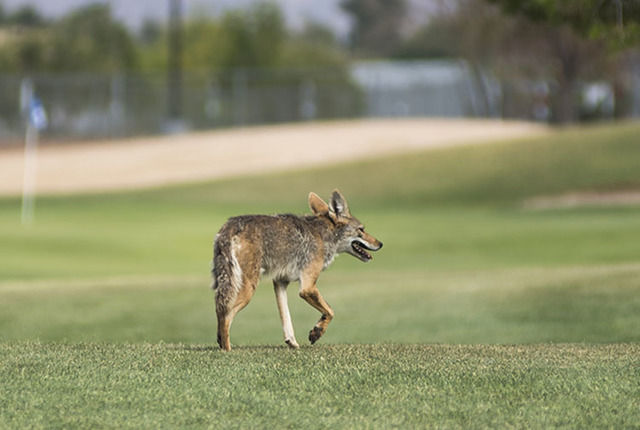Why do coyotes move into Las Vegas? Same reasons humans do

Coyotes and other city-dwelling critters can be an unpleasant surprise, especially for new Southern Nevadans.
“I’m told every week, ‘I moved to Las Vegas because I didn’t want to deal with wildlife. I didn’t even know we had wildlife,’” Nevada Department of Wildlife urban wildlife coordinator Joshua Cerda told about 50 attendees Aug. 16 at a “Living with Urban Coyotes” lecture.
Even dense urban centers such as New York City and Chicago have rampant wildlife, he said at the evening event in the main theater at the Clark County Library. In the Las Vegas Valley, there’s an added lure: numerous golf courses that function as an “all-inclusive resort” for a coyote seeking a respite from the far less hospitable rural Mojave Desert.
“Whenever you build golf course communities right on the edge of town, it’s going to attract wildlife,” Cerda said, adding that wildlife also can access parks close to the middle of Las Vegas via washes and flood channels.
Cerda’s solution: Make coyotes feel unwelcome, in part by not providing food, water and shelter.
Department of Wildlife staff specialist Pat Jackson took the microphone next and conducted a “fact or myth” quiz, inviting the crowd to answer out loud:
Myth or fact: Coyotes are easy to identify.
Answer: Myth and fact. “Coyotes are often mistaken for a whole slew of different things, most commonly wolves and sometimes domestic dogs,” Jackson said. “The average size is 22-45 pounds.”
Myth or fact: Coyotes were here first.
Myth and fact. Deforestation, removal of wolves and suburban landscapes have contributed to coyotes’ proliferation.
Myth or fact: Coyotes are carnivores.
Myth and fact. “They’re more accurately an opportunistic omnivore” that will eat anything, Jackson said.
Myth or fact: Coyotes are naturally nocturnal.
Myth. They only function at night in urban environments.
Myth or fact: Coyotes thrive in urban environments.
Fact. They fare better in Chicago than outside the city, Jackson said.
Myth or fact: Coyotes are passive creatures.
Myth. They defend territories, including from pets.
Myth or fact: We can get rid of coyotes.
Myth. They are resilient and eventually will recolonize an area if they’re removed.
Carl Frey, a wildlife biologist with the U.S. Department of Agriculture’s Animal and Plant Health Inspection Service, said golf courses aren’t the only alluring urban spots for coyotes. Some residents’ lush, green landscaping also gives the animals a place to hide — and feed.
His solutions to avoid problem coyotes: Feed pets inside, turn on talk radio outdoors when leaving the home so it sounds like someone is there, get balloons that move in the wind and can trick coyotes, avoid attracting prey via bird feeders and koi ponds, don’t leave fruit from trees on the ground, and carry pepper spray.
A question-and-answer session followed the hourlong talk. Some questions covered how to get permits for trapping coyotes and what to do when one finds an injured coyote, and the answer was to call the department at 702-486-5127, ext. 3851.
Cerda and lecture moderator Jess Brooks, wildlife education coordinator with the Department of Wildlife, emphasized the importance of staying in control when walking a dog.
“You want to have your dog right next to you, so that coyote associates you and the animal together,” Cerda said. “If you have a small dog, pick it up.” Running away is the worst thing an owner and pet can do, he said.
A man asked if coyotes have any natural predators.
The answer is basically no, as a mountain lion is unlikely to attack a coyote, Cerda said.
They’re also a keystone species, which means they’re a very integral part of the environment,” he said. “Without them, it throws the Mojave Desert completely out of whack. You’d see a lot of prey species, a lot of plant species not being eaten, more fires.”
Contact Brian Sandford at bsandford@viewnews.com or call 702-380-4531. Follow @nweditor on Twitter.